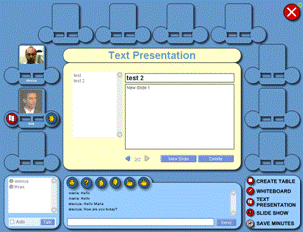Virtual Conference Services
As the need for synchronous communication and collaboration among geographically scattered users is increasing, The Lab of Distributed Systems and Telematics conducts both research and development on methods, tools and applications that integrate various types of functionality for supporting and facilitating the collaborative processes. The following figure show a virtual conferencing scenario:

Some of the services integrated for the realistic and effective virtual conferencing are:
- Collaborative Area, where the users can share applications such as Share Whiteboard, Slide Show and Prepare Slides with other participants. The “shared whiteboard” tool supports the user in making various actions such as: to write text, draw lines/arrows, draw a rectangle, erase an object in the whiteboard, resize an object in the whiteboard and change colors. The “slide show” tool could be used for making shared Macromedia flash presentations. The “prepare slides” tool supports the users to collaboratively create an on-line presentation by using various features such as: viewing of ready slides, shared navigation, creation and deletion of a slide.
- Text Chat Area, which provides to the user the opportunity to send and receive short messages to and from other members of the community respectively.
- Voice Chat Area, where the user has the ability to talk with other members of the community.
- Gestures Area, where the user can select an icon gesture (i.e. agree, disagree, bye, etc.) so as to make the conversation with other members more efficient and realistic. The gestures appear next to the member’s avatar image.
- User Representation Area, where a photo represents each user. Further features in this area inform the other participants about the shared tool that the user currently uses as well as about her/his feeling represented by an icon-gesture.
- Sharing Applications Area, where the user can select an application (whiteboard, slide show and prepare slides) s/he want to share with other participants. In addition the last user who has remained in the virtual conference room has the ability to save the log files/minutes of the chat for the conference session.
Every tool designed for supporting e-collaboration should exploit aspects of space and spatial mechanisms, such as providing identity, orientation, a locus for activity, and a mode of control, which can be considered as powerful tools for the design. These aspects are: a) relational orientation and reciprocity, b) proximity and activity, c) partitioning, d) presence, awareness and support of users’ representation.
